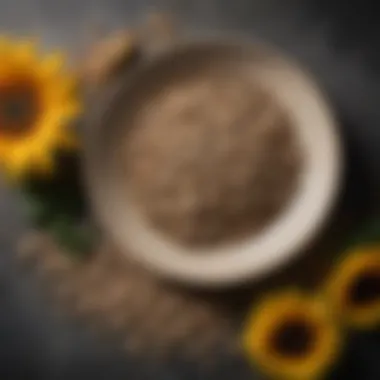Unearthing the Fascinating Journey of Sunflower Seeds from Plant to Plate


Journey of Sunflower Seeds from Plant to Plate
Plant Growth and Development
Sunflowers, scientifically known as Helianthus annuus, display a remarkable growth pattern, characterized by their heliotropic nature as they track the sun's movement throughout the day. The plant's striking yellow flowers bloom in a clockwise pattern, attracting pollinators such as bees and butterflies to aid in the fertilization process. The bright petals eventually wither and fall, making way for the formation of the sunflower seed.
Cultivation Techniques
Cultivating sunflowers requires meticulous planning and care. These plants thrive in locations with abundant sunlight, well-draining soil, and adequate spacing for optimal growth. Farmers strategically plant sunflower seeds in rows, ensuring proper irrigation and nutrient supplementation to encourage robust development. As the sunflower matures, it transitions from flowering to seed production, signaling the next phase of the journey.
Harvesting and Processing
The harvesting of sunflower seeds is a critical stage that demands precision and timing. Farmers monitor the maturation of the seeds closely, observing the telltale signs of ripeness such as the drying and darkening of the flower head. Once ready, the sunflower heads are harvested and the seeds meticulously extracted for further processing. Threshing and winnowing techniques are employed to separate the seeds from the chaff, ensuring high-quality yield for consumption.
Nutritional Value and Culinary Applications
Sunflower seeds are a powerhouse of nutrients, packed with essential vitamins, minerals, and beneficial fats. These versatile seeds are widely used in various culinary dishes, ranging from salads and baked goods to snacks and garnishes. Their crunchy texture and nutty flavor make them a popular choice for both savory and sweet recipes, adding a nutritional boost to meals.
Conclusion
Introduction to Sunflower Seeds
In the realm of botanical marvels, sunflower seeds stand out as a fascinating subject of exploration. The journey from plant to plate unveils a symphony of processes that culminate in the delightful kernels we enjoy. This section serves as a gateway to understanding the intricate world of sunflower seeds, shedding light on their significance, versatility, and allure.
An Overview of Sunflower Plants
Botanical Classification of Sunflowers
Delving into the botanical classification of sunflowers opens a portal to their genetic makeup and evolutionary lineage. Sunflowers belong to the family Asteraceae, known for their composite flower heads and fertile disc florets. This botanical distinction plays a pivotal role in shaping the characteristics of sunflowers, emphasizing their resilience in diverse environments and adaptive breeding profiles. The unassuming beauty of the Helianthus genus encapsulates the essence of sunflowers, making them a favored choice for botanical enthusiasts and researchers seeking evolutionary insights.
Characteristics of Sunflower Plants
The allure of sunflower plants lies in their striking features, from their towering stature to their efficient nutrient absorption mechanisms. Sunflower plants exhibit heliotropism, a dynamic response to solar positioning that enhances photosynthetic efficiency. This unique characteristic not only showcases the adaptability of sunflowers but also underlines their agricultural significance in optimizing yield production. Embracing a rich palette of colors and shapes, sunflower plants weave a tapestry of biodiversity that stands as a testament to nature's creative abundance.
Historical Significance of Sunflowers
Cultural and Culinary Importance
Tracing the historical trajectory of sunflowers unveils a tapestry woven with cultural and culinary threads. Across civilizations, sunflowers have symbolized vitality, prosperity, and nourishment, transcending mere botanical significance to embody cultural ideologies. From the culinary prowess of sunflower oil to the artisanal delights of roasted seeds, sunflowers have entrenched themselves deeply in human gastronomy, offering both sustenance and indulgence. Their versatility in traditional cuisines and modern delicacies underscores their enduring appeal in culinary spheres.


Symbolism and Mythology
In the realm of symbolism and mythology, sunflowers emerge as potent symbols of adoration, loyalty, and spiritual growth. Ancient mythologies interweave tales of sunflower deities and celestial connections, elevating these humble blooms to celestial realms. Symbolizing the sun's radiance and unwavering resilience, sunflowers embody themes of optimism and transformation, resonating with individuals seeking inspiration and solace in the intricacies of natural symbolism.
Life Cycle of Sunflower Plants
When delving into the topic of the life cycle of sunflower plants, one immediately grasps the intricate journey from seed germination to full bloom. Understanding this cycle is vital in unraveling the essence of sunflower seed production. Commencing with the wondrous process of seed germination, we witness the miraculous transformation from a dormant seed to a vibrant seedling, symbolizing new beginnings and growth. Moving on to maturity and flowering, we observe the pinnacle of the sunflower's life cycle, where the plant reaches its full potential, flaunting its iconic yellow petals and robust structure. It is crucial to highlight these phases to comprehend the fundamental stages leading to the eventual harvest of sunflower seeds.
Seed Germination and Growth
Seedling Stage:
Embarking on the seedling stage, we encounter the initial sprouting of the sunflower seed, signifying the genesis of life within the plant. This phase is characterized by rapid growth, as the seed transforms into a young seedling, exuding vitality and promise. The resilience of the seedling stage sets the foundation for a strong and healthy sunflower plant, a key factor in successful seed production. Despite its delicacy, the seedling stage is a crucial step in the plant's life cycle, fostering robust growth and development.
Maturity and Flowering:
Transitioning into the maturity and flowering phase, we witness the crowning glory of the sunflower plant. As the plant matures, it showcases its distinctive yellow petals, attracting pollinators and heralding the onset of seed formation. The blooming of the sunflower signifies a harmonious collaboration between nature and the plant, culminating in the production of seeds essential for culinary and nutritional purposes. This phase exemplifies nature's brilliance, underscoring the plant's transformation from flower to seed-bearing entity.
Pollination Process
Role of Bees and Pollinators:
Exploring the crucial role of bees and other pollinators in the sunflower's pollination process unveils a symphony of ecological interdependence. Bees, in their diligent quest for nectar, inadvertently transfer pollen between sunflower blooms, facilitating fertilization and seed development. The intricate dance of pollination orchestrated by these tiny marvels highlights the indispensable part they play in ensuring abundant seed production.
Fertilization of Sunflower Seeds:
Delving into the fertilization process of sunflower seeds sheds light on the intricate mechanisms behind seed maturation. Following successful pollination, the fusion of pollen with the ovule initiates the transformation of the flower into a seed. This fertilization process is a pivotal stage in seed development, marking the beginning of seed maturation and eventual harvest. Understanding the nuances of fertilization deepens our appreciation for the intricate processes driving sunflower seed production, underscoring the importance of pollination in the cultivation of these nutrient-rich seeds.
Cultivation and Harvesting Practices
In delving into the intricacies of sunflower seed production, understanding the cultivation and harvesting practices becomes pivotal. This section sheds light on the meticulous processes involved in nurturing sunflowers from seed to harvest, ensuring optimal yield and quality. Cultivation and harvesting practices play a crucial role in ensuring the successful growth and development of sunflower plants, ultimately determining the quantity and quality of the sunflower seeds produced.
Ideal Growing Conditions
Soil Requirements
When considering ideal growing conditions for sunflowers, the soil requirements hold significant importance. Sunflowers thrive in well-drained, loamy soil with a slightly acidic to neutral p H level. The key characteristic of soil requirements lies in its ability to provide essential nutrients and oxygen to the sunflower roots, facilitating healthy growth and development. This type of soil is a popular choice for cultivating sunflowers due to its optimal drainage properties, preventing waterlogging and root rot. The unique feature of soil requirements is its capacity to support robust root systems, enabling sunflowers to efficiently absorb nutrients for optimal growth. While soil requirements offer numerous advantages in fostering healthy sunflower plants, it is essential to maintain proper soil pH and nutrient levels to maximize seed production.
Climate Preferences


Another crucial aspect of ideal growing conditions for sunflowers is climate preferences. Sunflowers thrive in warm climates with plenty of sunlight, requiring temperatures between 70-78°F during the growing season. The key characteristic of climate preferences is the abundance of sunlight, which is vital for photosynthesis and the maturation of sunflower seeds. This climate is a beneficial choice for sunflower cultivation as it promotes healthy plant growth and enhances seed development. The unique feature of climate preferences is the balance between warmth and sunlight, providing optimal conditions for sunflower plants to flourish. While sunflowers can adapt to various climatic conditions, a warm and sunny climate is advantageous for maximizing seed yield and quality.
Harvesting Sunflower Heads
Timing and Methods
The timing and methods of harvesting sunflower heads are essential considerations in the seed production process. Harvesting should occur when the sunflower heads have fully matured but before the seeds start to shed. The key characteristic of timing and methods lies in ensuring that the seeds are fully developed and matured, guaranteeing a higher oil content and better seed quality. This approach is a popular choice for sunflower farmers as it maximizes seed yield and oil extraction efficiency. The unique feature of timing and methods is the precision required to harvest sunflower heads at the optimal stage, enhancing the overall quality of the seeds. While timely harvesting enhances seed quality, it is crucial to employ gentle methods to prevent seed damage and ensure a successful harvest.
Post-Harvest Processing
Post-harvest processing is a critical phase in the journey of sunflower seeds from plant to plate. Upon harvesting, sunflower heads undergo cleaning, drying, and seed extraction processes to prepare them for consumption. The key characteristic of post-harvest processing is its role in preserving seed quality and enhancing shelf life. This phase is a beneficial choice for seed producers as it ensures that the seeds are free from impurities and contaminants. The unique feature of post-harvest processing is its contribution to the overall seed quality, ensuring that only the best seeds are selected for consumption. While post-harvest processing offers numerous advantages in terms of seed preservation and quality control, it is essential to adopt efficient processing methods to maintain the nutritional integrity of the sunflower seeds.
Processing Sunflower Seeds
In the journey of sunflower seeds from plant to plate, the processing stage plays a crucial role. Processing sunflower seeds involves various steps that are essential in preparing the seeds for consumption. From seed extraction to cleaning and refining, each step contributes to the quality and flavor of the final product. This section will delve into the significance of processing sunflower seeds, highlighting its importance in ensuring that the seeds are safe, flavorful, and nutritionally valuable for consumers.
Seed Extraction and Cleaning
Mechanical Extraction Methods
When it comes to extracting sunflower seeds efficiently, mechanical extraction methods have proven to be instrumental. These methods involve the use of machinery and equipment to separate the seeds from the flower heads effectively. The key characteristic of mechanical extraction is its ability to process a large volume of seeds in a relatively short period, making it a popular choice for commercial sunflower seed production. Despite the mechanized approach, mechanical extraction methods are known for their precision and consistency in seed separation, ensuring high-quality output for further processing.
Quality Control Measures
In the realm of processing sunflower seeds, quality control measures are implemented to maintain the standards of the final product. These measures encompass various protocols and checks that are designed to monitor and uphold the quality of the extracted seeds. By adhering to strict quality control measures, producers can safeguard the purity, taste, and nutritional value of the sunflower seeds. While quality control measures add an extra layer of scrutiny to the processing stage, they are indispensable in delivering premium sunflower seed products to consumers.
Roasting and Flavor Enhancement
In elevating the flavor profile of sunflower seeds, roasting and flavor enhancement techniques come into play. Roasting techniques involve applying heat to the seeds to improve their crunchiness and develop a roasted flavor profile. This method is favored for enhancing the taste and texture of sunflower seeds, making them more palatable for consumption. On the other hand, seasoning and variations provide a diverse range of flavors and textures to sunflower seeds. By infusing spices, herbs, and seasonings, producers can cater to different taste preferences and create innovative sunflower seed products that appeal to a wide audience. Seasoning and variations offer versatility in culinary applications, expanding the possibilities of using sunflower seeds in various dishes and recipes.
Roasting Techniques
When exploring roasting techniques for sunflower seeds, the focus is on achieving the perfect balance of crispiness and flavor. Different roasting methods, such as dry roasting or oil roasting, influence the final taste and texture of the seeds. Each technique brings its unique element to the roasting process, enhancing the overall sensory experience for consumers. The art of roasting sunflower seeds lies in finding the ideal combination of temperature, time, and technique to produce consistently delicious and crunchy seeds.
Seasoning and Variations
Seasoning and variations in sunflower seeds offer a canvas for culinary creativity. From classic salted seeds to bold and imaginative flavors, the possibilities are endless. Seasoning sunflower seeds with spices like paprika, garlic, or even honey can create a myriad of taste sensations that cater to diverse palates. These variations not only add excitement to snacking but also open doors to using sunflower seeds in salads, baked goods, and other culinary creations. Experimenting with different seasoning blends allows producers to innovate and introduce unique sunflower seed products to the market, meeting the evolving preferences of consumers.
Nutritional Benefits and Culinary Uses


In this section, we will unravel the significance of the Nutritional Benefits and Culinary Uses of sunflower seeds within the broader context of the article. Understanding the nutritional composition and culinary versatility of sunflower seeds is vital for appreciating their role in modern cuisine and overall health. Sunflower seeds are a powerhouse of essential nutrients, including but not limited to protein, fiber, healthy fats, vitamins, and minerals. Their versatility in culinary applications ranges from salads, baked goods, granolas, to being enjoyed roasted as a snack.
Health Benefits of Sunflower Seeds
Nutrient Profile
Diving deep into the Nutrient Profile of sunflower seeds sheds light on the exceptional nutritional value they offer. Rich in Omega-3 fatty acids and antioxidants such as Vitamin E, sunflower seeds are renowned for their heart-healthy properties. The presence of vital minerals like magnesium and selenium further enhances their nutritional profile, making them a popular choice for those seeking a balanced diet. The unique feature of sunflower seeds' Nutrient Profile lies in their ability to promote cardiovascular health, aid in cell regeneration, and support overall well-being.
Potential Health Effects
Exploring the Potential Health Effects of sunflower seeds reveals their impact on various aspects of health. From improving cholesterol levels to reducing the risk of chronic diseases, sunflower seeds pack a nutritious punch. The key characteristic of their Potential Health Effects is the ability to boost immunity, promote skin health, and aid in digestion. While their high calorie and fat content may require moderate consumption, the advantages of incorporating sunflower seeds into a diet outweigh any potential disadvantages, offering a range of health benefits.
Diverse Culinary Applications
Snack Options
Analyzing the Snack Options provided by sunflower seeds enlightens us on their role as a convenient and nourishing snack choice. Whether enjoyed raw or roasted, their crunchy texture and nutty flavor make them a satisfying snack option. The key characteristic of sunflower seeds as snacks is their portability and long shelf life, allowing for a quick energy boost on-the-go. While their calorie content needs to be considered, the benefits of incorporating sunflower seeds as snacks in moderation include improved satiety and nutrient intake.
Incorporation in Recipes
Delving into how sunflower seeds can be incorporated into recipes showcases their versatility in enhancing dishes both in flavor and nutrition. From sprinkling them on salads for added crunch to using them as a natural thickening agent in sauces, sunflower seeds offer a subtle nuttiness that elevates various recipes. The unique feature of integrating sunflower seeds into recipes is their ability to infuse dishes with texture and richness without overpowering other flavors. Despite their allergenic potential in some individuals, the advantages of using sunflower seeds in recipes extend to increasing nutrient content and diversifying menu options.
Sunflower Seeds in Modern Culture
In the contemporary landscape, sunflower seeds hold a place of significance in modern culture, transcending their historical roots to become a versatile and widely utilized ingredient. Their inclusion in various culinary dishes, snacks, and products underscores their popularity and nutritional value. Sunflower seeds have become a staple ingredient not only for their taste but also for their numerous health benefits, leading to a growing demand globally.
Market Trends and Consumption
Global Demand
The global demand for sunflower seeds has been on a steady rise, driven by the increasing awareness of their health benefits and culinary versatility. Sunflower seeds are sought after for their rich nutrient profile, including essential vitamins, minerals, and antioxidants. Their role as a source of plant-based protein has also contributed to their popularity. The global demand for sunflower seeds is a testament to their widespread acceptance and integration into diverse cuisines and dietary choices.
Emerging Food Trends
Sunflower seeds have seamlessly adapted to emerging food trends, aligning with the increasing consumer focus on healthy and sustainable eating habits. Their incorporation in plant-based diets, gluten-free recipes, and vegan products has positioned them as a go-to ingredient for health-conscious individuals. The rising interest in seed cycling and mindfulness around nutrient-dense foods has further propelled the consumption of sunflower seeds, making them a versatile and sought-after ingredient.
Innovative Uses and Products
Sunflower Seed Oil
Among the innovative uses of sunflower seeds, sunflower seed oil stands out as a versatile and nutritious option. Known for its light flavor and high smoke point, sunflower seed oil is ideal for cooking, baking, and salad dressings. Its neutral taste makes it a preferred choice for those seeking a healthier alternative to conventional cooking oils. Additionally, sunflower seed oil's rich omega-6 fatty acid content and vitamin E content make it a valuable addition to a balanced diet.
Alternative Applications
Beyond sunflower seed oil, alternative applications of sunflower seeds have gained traction, showcasing their adaptability in various industries. From their incorporation in skincare products for their hydrating properties to their use in bird feed and animal nutrition due to their high protein content, sunflower seeds have diversified their presence. The versatility of sunflower seeds in alternative applications highlights their potential beyond culinary uses, paving the way for innovative products and utilization.







